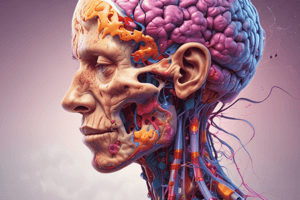Podcast
Questions and Answers
What is the definition of a brain abscess?
What is the definition of a brain abscess?
- A localized area of inflammation in the brain.
- A localized area of suppuration of brain tissue. (correct)
- A localized area of necrotic brain tissue.
- A diffuse area of infection throughout the brain.
Which of the following is NOT a route of infection for brain abscesses?
Which of the following is NOT a route of infection for brain abscesses?
- Direct extension from adjacent infections.
- Via cerebrospinal fluid.
- Hematogenous spread.
- Exposure to environmental toxins. (correct)
Which condition involves localized areas of inflammation in the heart?
Which condition involves localized areas of inflammation in the heart?
- Endarteritis obliterans.
- Endocarditis. (correct)
- Brain abscess.
- Conjunctivitis.
What is a common symptom that might accompany conjunctivitis?
What is a common symptom that might accompany conjunctivitis?
Which term refers to the inflammation of blood vessels that can lead to insufficient blood flow?
Which term refers to the inflammation of blood vessels that can lead to insufficient blood flow?
What condition can result from obstruction of cerebrospinal fluid (CSF)?
What condition can result from obstruction of cerebrospinal fluid (CSF)?
Which cranial nerves are commonly associated with arthritis-related palsies?
Which cranial nerves are commonly associated with arthritis-related palsies?
What is a potential complication from thrombophlebitis?
What is a potential complication from thrombophlebitis?
What is a common pathway for cerebrospinal fluid to the subdural and extradural spaces?
What is a common pathway for cerebrospinal fluid to the subdural and extradural spaces?
Which condition is least likely to cause cranial nerve compression?
Which condition is least likely to cause cranial nerve compression?
What are the primary components that make up brain substance?
What are the primary components that make up brain substance?
Which type of glial cell is primarily responsible for providing nutritional support in the brain?
Which type of glial cell is primarily responsible for providing nutritional support in the brain?
Astrocytes play which crucial role in the brain's functionality?
Astrocytes play which crucial role in the brain's functionality?
Which of the following is NOT a component of brain substance?
Which of the following is NOT a component of brain substance?
What is the role of neurons in brain substance?
What is the role of neurons in brain substance?
Flashcards
Brain abscess
Brain abscess
A localized collection of pus within brain tissue.
How do brain abscesses form?
How do brain abscesses form?
Routes of infection:
- Hematologically
- Directly (e.g., trauma, surgery)
- Contiguous spread (e.g., from sinusitis, otitis media)
Hematologic spread of brain abscess
Hematologic spread of brain abscess
The most common cause of brain abscesses. Bacteria spread through the bloodstream.
Direct spread of brain abscess
Direct spread of brain abscess
Signup and view all the flashcards
Contiguous spread of brain abscess
Contiguous spread of brain abscess
Signup and view all the flashcards
Neurons
Neurons
Signup and view all the flashcards
Glial cells
Glial cells
Signup and view all the flashcards
Astrocytes
Astrocytes
Signup and view all the flashcards
Oligodendrocytes
Oligodendrocytes
Signup and view all the flashcards
Oligodendrocytes
Oligodendrocytes
Signup and view all the flashcards
What happens when CSF flow is blocked?
What happens when CSF flow is blocked?
Signup and view all the flashcards
How can thrombophlebitis affect cranial nerves?
How can thrombophlebitis affect cranial nerves?
Signup and view all the flashcards
What causes hydrocephalus?
What causes hydrocephalus?
Signup and view all the flashcards
How does fibrosis contribute to hydrocephalus?
How does fibrosis contribute to hydrocephalus?
Signup and view all the flashcards
How can otitis media affect the brain?
How can otitis media affect the brain?
Signup and view all the flashcards
Study Notes
Diseases of the CNS
- The nervous system is distinct from other systems as each part of the brain has specialized functions.
- Brain tissue is composed of neurons (nerve cells and fibers) and supporting glial cells (astrocytes, oligodendrocytes, microglial cells).
Neurodegenerative Diseases
- Characterized by progressive loss of neurons, particularly those with intricate functional connections.
- Affect various brain regions, including the hippocampus and cortex (cognitive changes), basal ganglia (movement disorders), and cerebellum (ataxia).
- Alzheimer's disease is a common form, often linked to protein aggregates (Aβ and tau).
- Parkinson's disease is a neurodegenerative disorder resulting from dopaminergic neuron loss in the substantia nigra, leading to symptoms such as tremor, rigidity, bradykinesia, and instability.
Increased Intracranial Pressure
- Defined as CSF pressure exceeding 15 mmHg (200 mm water) in the lateral decubitus position.
- Potential causes include space-occupying lesions, cerebral edema, and obstructive hydrocephalus.
- Common symptoms include projectile vomiting, headache, papilledema, and decreased level of consciousness.
Meningitis
- Inflammation of the leptomeninges (membranes covering the brain and spinal cord) and the subarachnoid space.
- Types include acute pyogenic (bacterial), acute lymphocytic (viral/tuberculosis), and chronic (bacterial/fungal).
- Infection routes can be via the bloodstream (most common) or direct implantation.
- Common causative organisms for acute pyogenic meningitis include E. coli (neonates), H. influenzae (infants and children), N. meningitides (adolescents and young adults), and pneumococcus (very young and old).
Clinical Picture of Meningitis
- General signs of infection, including fever, malaise, and rigor, and petechial eruption.
- Meningeal irritation signs, such as headache, neck stiffness, photophobia, and irritability are common findings.
Complications of Meningitis
- Infection spread to the ventricles, extradural spaces, or thrombophlebitis.
- Possible complications include arthritis, otitis media, endocarditis, and conjunctivitis.
- Healing can lead to fibrosis, obstructive hydrocephalus, compression of cranial nerves, and brain infarcts.
Brain Abscess
- Localized brain tissue suppuration.
- Infection routes include direct implantation (trauma), local extension (e.g., mastoiditis), and hematogenous spread (e.g., from endocarditis).
- Common causative organisms are Staphylococcus aureus, Streptococcus species, and pneumococci, and E. coli.
CNS Trauma
- Includes epidural hematoma, subdural hematoma, and traumatic parenchymal injuries (concussion, diffuse axonal injury, contusion).
Concussion
- Transient loss of consciousness following head trauma.
- Associated symptoms like widespread paralysis, seizures and memory loss about the trauma are common.
- Typically resolves within hours or days with complete recovery, with no lasting anatomical lesion.
Hydrocephalus
- Abnormal dilatation of the ventricular system due to excessive cerebrospinal fluid with brain tissue atrophy.
- Types include communicating and non-communicating hydrocephalus.
Brain Tumors (Primary)
- Benign tumors can be fatal if located in critical positions.
- Usually infiltrative, making complete resection impossible.
- They rarely metastasize but can spread through the cerebrospinal fluid.
- Symptoms arise from local effects and from increasing intracranial pressure.
Tumors of the Nervous System
- Classification includes primary parenchymal, primary non-parenchymal, and metastatic tumors.
- Primary parenchymal tumors originate from neuroglia (e.g., astrocytes, oligodendrocytes, ependymal cells).
- Primary non-parenchymal tumors originate from meninges, nerve sheath cells (e.g., schwannomas, neurofibromas), pituitary gland, or craniopharyngioma, and epidermoid/dermoid cysts.
- Common primary brain tumors include meningiomas.
- Metastatic tumors are the spread of cancer to the brain from other sites (e.g., lung, breast, skin, kidney, gastrointestinal tract).
Meningioma
- Often arises in the front half of the cranial cavity (hemispheric convexity).
- Develops from meningothelial cells of the arachnoid.
- Represents about 20% of primary brain tumors.
- Usually occurs in middle to later life and more common in females.
Studying That Suits You
Use AI to generate personalized quizzes and flashcards to suit your learning preferences.
Related Documents
Description
Explore the intricate world of central nervous system diseases, focusing on neurodegenerative disorders such as Alzheimer's and Parkinson's disease. This quiz covers the anatomical and functional aspects of the brain along with the implications of increased intracranial pressure. Test your knowledge on the specialized functions of brain regions and the effects of neuron loss.




